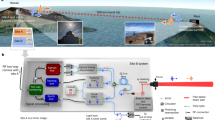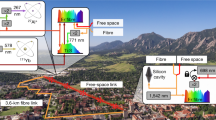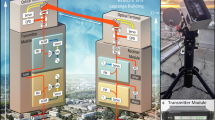Abstract
Networks of optical clocks find applications in precise navigation1,2, in efforts to redefine the fundamental unit of the ‘second’3,4,5,6 and in gravitational tests7. As the frequency instability for state-of-the-art optical clocks has reached the 10−19 level8,9, the vision of a global-scale optical network that achieves comparable performances requires the dissemination of time and frequency over a long-distance free-space link with a similar instability of 10−19. However, previous attempts at free-space dissemination of time and frequency at high precision did not extend beyond dozens of kilometres10,11. Here we report time–frequency dissemination with an offset of 6.3 × 10−20 ± 3.4 × 10−19 and an instability of less than 4 × 10−19 at 10,000 s through a free-space link of 113 km. Key technologies essential to this achievement include the deployment of high-power frequency combs, high-stability and high-efficiency optical transceiver systems and efficient linear optical sampling. We observe that the stability we have reached is retained for channel losses up to 89 dB. The technique we report can not only be directly used in ground-based applications, but could also lay the groundwork for future satellite time–frequency dissemination.
This is a preview of subscription content, access via your institution
Access options
Access Nature and 54 other Nature Portfolio journals
Get Nature+, our best-value online-access subscription
$29.99 / 30 days
cancel any time
Subscribe to this journal
Receive 51 print issues and online access
$199.00 per year
only $3.90 per issue
Buy this article
- Purchase on Springer Link
- Instant access to full article PDF
Prices may be subject to local taxes which are calculated during checkout



Similar content being viewed by others
Data availability
All data generated or analysed during this study are included in this published article (and its supplementary information files).
Code availability
All relevant codes or algorithms are available from the corresponding author upon reasonable request.
References
Mehlstäubler, T. E., Grosche, G., Lisdat, C., Schmidt, P. O. & Denker, H. Atomic clocks for geodesy. Rep. Prog. Phys. 81, 064401 (2018).
Lisdat, C. et al. A clock network for geodesy and fundamental science. Nat. Commun. 7, 12443 (2016).
Riehle, F., Gill, P., Arias, F. & Robertsson, L. The CIPM list of recommended frequency standard values: guidelines and procedures. Metrologia 55, 188–200 (2018).
Riehle, F. Towards a redefinition of the second based on optical atomic clocks. C. R. Phys. 16, 506–515 (2015).
McGrew, W. F. et al. Towards the optical second: verifying optical clocks at the SI limit. Optica 6, 448 (2019).
Bize, S. The unit of time: present and future directions. C. R. Phys. 20, 153–168 (2019).
Kolkowitz, S. et al. Gravitational wave detection with optical lattice atomic clocks. Phys. Rev. D 94, 124043 (2016).
Campbell, S. L. et al. A fermi-degenerate three-dimensional optical lattice clock. Science 358, 90–94 (2017).
McGrew, W. et al. Atomic clock performance enabling geodesy below the centimetre level. Nature 564, 87 (2018).
Deschênes, J.-D. et al. Synchronization of distant optical clocks at the femtosecond level. Phys. Rev. X 6, 021016 (2016).
Sinclair, L. C. et al. Synchronization of clocks through 12 km of strongly turbulent air over a city. Appl. Phys. Lett. 109, 151104 (2016).
Derevianko, A. & Pospelov, M. Hunting for topological dark matter with atomic clocks. Nat. Phys. 10, 933–936 (2014).
Delva, P. et al. Test of special relativity using a fiber network of optical clocks. Phys. Rev. Lett. 118, 221102 (2017).
Safronova, M. S. et al. Search for new physics with atoms and molecules. Rev. Mod. Phys. 90, 025008 (2018).
Chin, C., Flambaum, V. V. & Kozlov, M. G. Ultracold molecules: new probes on the variation of fundamental constants. New J. Phys. 11, 055048 (2009).
Roberts, B. M. et al. Search for transient variations of the fine structure constant and dark matter using fiber-linked optical atomic clocks. New J. Phys. 22, 093010 (2020).
Liu, Y. et al. Experimental twin-field quantum key distribution through sending or not sending. Phys. Rev. Lett. 123, 100505 (2019).
Droste, S. et al. Optical-frequency transfer over a single-span 1840 km fiber link. Phys. Rev. Lett. 111, 110801 (2013).
Predehl, K. et al. A 920-kilometer optical fiber link for frequency metrology at the 19th decimal place. Science 336, 441–444 (2012).
Cantin, E. et al. An accurate and robust metrological network for coherent optical frequency dissemination. New J. Phys. 23, 053027 (2021).
Katori, H. Optical lattice clocks and quantum metrology. Nat. Photonics 5, 203 (2011).
Giorgetta, F. R. et al. Optical two-way time and frequency transfer over free space. Nat. Photonics 7, 434 (2013).
Bodine, M. I. et al. Optical time-frequency transfer across a free-space, three-node network. APL Photonics 5, 076113 (2020).
Shen, Q. et al. Experimental simulation of time and frequency transfer via an optical satellite-ground link at 10 -18 instability. Optica 8, 471 (2021).
Bodine, M. I. et al. Optical atomic clock comparison through turbulent air. Phys. Rev. Res. 2, 33395 (2020).
Beloy, K. et al. Frequency ratio measurements at 18-digit accuracy using an optical clock network. Nature 591, 564–569 (2021).
Bergeron, H. et al. Femtosecond time synchronization of optical clocks off of a flying quadcopter. Nat. Commun. 10, 1819 (2019).
Sinclair, L. C. et al. Comparing optical oscillators across the air to milliradians in phase and 10−17 in frequency. Phys. Rev. Lett. 120, 050801 (2018).
Gozzard, D. R. et al. Ultrastable free-space laser links for a global network of optical atomic clocks. Phys. Rev. Lett. 128, 020801 (2022).
Samain, E. et al. Time transfer by laser link: a complete analysis of the uncertainty budget. Metrologia 52, 423–432 (2015).
Cacciapuoti, L. & Schiller, S. I-SOC Scientific Requirements Technical Report (European Space Research and Technology Centre, 2017).
Exertier, P. et al. Time and laser ranging: a window of opportunity for geodesy, navigation, and metrology. J. Geod. 93, 2389–2404 (2019).
Robert, C., Conan, J.-M. & Wolf, P. Impact of turbulence on high-precision ground-satellite frequency transfer with two-way coherent optical links. Phys. Rev. A 93, 033860 (2016).
Swann, W. C. et al. Measurement of the impact of turbulence anisoplanatism on precision free-space optical time transfer. Phys. Rev. A 99, 023855 (2019).
Strohbehn, J. W. (ed.) Laser Beam Propagation in the Atmosphere Topics in Applied Physics Vol. 25 (Springer, 1978); https://doi.org/10.1007/3-540-08812-1
Conan, J.-M., Rousset, G. & Madec, P.-Y. Wave-front temporal spectra in high-resolution imaging through turbulence. J. Opt. Soc. Am. A 12, 1559–1570 (1995).
Bauch, A. et al. Comparison between frequency standards in europe and the usa at the 10−15 uncertainty level. Metrologia 43, 109–120 (2006).
Fujieda, M. et al. Advanced satellite-based frequency transfer at the 10−16 level. IEEE Trans. Ultrason. Ferroelectr. Freq. Control 65, 973–978 (2018).
Schioppo, M. et al. Ultrastable optical clock with two cold-atom ensembles. Nat. Photonics 11, 48–52 (2017).
Oelker, E. et al. Demonstration of 4.8 × 10−17 stability at 1 s for two independent optical clocks. Nat. Photonics 13, 714–719 (2019).
Calosso, C. E., Clivati, C. & Micalizio, S. Avoiding aliasing in allan variance: an application to fiber link data analysis. IEEE Trans. Ultrason. Ferroelectr. Freq. Control 63, 646–655 (2016).
Acknowledgements
This work is supported by the National Key Research and Development Programme of China (grant nos. 2017YFA0303900, 2020YFA0309800 and 2020YFC2200103); the Strategic Priority Research Programme of Chinese Academy of Sciences (grant nos. XDB35030000 and XDA15020400); the National Natural Science Foundation of China (grant nos. T2125010 and 61825505); the Anhui Initiative in Quantum Information Technologies (grant no. AHY010100); the Key R&D Plan of Shandong Province (grant nos. 2020CXGC010105 and 2021ZDPT01); the Key Research and Development Programme of Guangdong Province (grant no. 2018B030325001); the Shanghai Municipal Science and Technology Major Project (grant no. 2019SHZDZX01); and the Innovation Programme for Quantum Science and Technology (grant no. 2021ZD0300100).
Author information
Authors and Affiliations
Contributions
H.-F.J., Q.Z. and J.-W.P. conceived the experiment. Q.S., J.-Y.G., L.H., M.L., J.-J.H., M.-Z.L., Y.-W.C., X.-X.P., H.-F.J. and Q.Z. designed the time and frequency setup. J.-G.R., Y.C., T.Z., J.-C.W., J.-J.J., J.Y. and C.-Z.P. built the optical telescopes. L.H., X.-X.P., Y.-Y.Z. and H.-F.J. developed the 1,563 nm OFCs and amplifiers. Q.S., M.L., J.-Y.G., J.-J.H., M.-Z.L. and S.-K.L. developed the LOS optics and electrics and the real-time synchronization modules. J.-Y.G., F.-X.C., H.-F.J., Q.S., J.-J.H. and M.-Z.L. developed the optical fibre transfer link. W.-Y.L., X.-P.S., Y.L., M.L., Q.S. and J.-Y.G. designed the data acquisition software of the LOS. J.-Y.G., Q.S., M.L., J.-J.H., M.-Z.L. and Y.-W.C. designed the time data process software. All authors carried out the experiment, analysed the data and contributed to the writing of the paper.
Corresponding authors
Ethics declarations
Competing interests
The authors declare no competing interests.
Peer review
Peer review information
Nature thanks the anonymous reviewers for their contribution to the peer review of this work.Peer reviewer reports are available.
Additional information
Publisher’s note Springer Nature remains neutral with regard to jurisdictional claims in published maps and institutional affiliations.
Extended data figures and tables
Extended Data Fig. 1 Detailed experimental optics setup of single terminal.
USL, ultra-stable laser; EDFA, erbium-doped fiber amplifiers; Cir, circulator; BPD, balanced photodiode; Tele, Telescope.
Extended Data Fig. 2 Setup for fibre time-frequency transfer.
USL, ultra-stable laser; SMC, single-mode coupler; PD, photon diode; RF, radio frequency source; FM, Faraday mirror; AOM, acoustic optical modulator; EPC, electric polarization controller; Bi-EDFA, bidirectional erbium doped fiber amplification.Underlying map from Google, DigitalGlobe.
Supplementary information
Supplementary Information
Supplementary text and figures.
Rights and permissions
Springer Nature or its licensor holds exclusive rights to this article under a publishing agreement with the author(s) or other rightsholder(s); author self-archiving of the accepted manuscript version of this article is solely governed by the terms of such publishing agreement and applicable law.
About this article
Cite this article
Shen, Q., Guan, JY., Ren, JG. et al. Free-space dissemination of time and frequency with 10−19 instability over 113 km. Nature 610, 661–666 (2022). https://doi.org/10.1038/s41586-022-05228-5
Received:
Accepted:
Published:
Issue Date:
DOI: https://doi.org/10.1038/s41586-022-05228-5
This article is cited by
-
Quantum-limited optical time transfer for future geosynchronous links
Nature (2023)
-
Clocks synchronized at the quantum limit
Nature (2023)
-
Artificial Intelligence-Enabled Mode-Locked Fiber Laser: A Review
Nanomanufacturing and Metrology (2023)
-
Chinese team syncs clocks over record distance using lasers
Nature (2022)
Comments
By submitting a comment you agree to abide by our Terms and Community Guidelines. If you find something abusive or that does not comply with our terms or guidelines please flag it as inappropriate.



